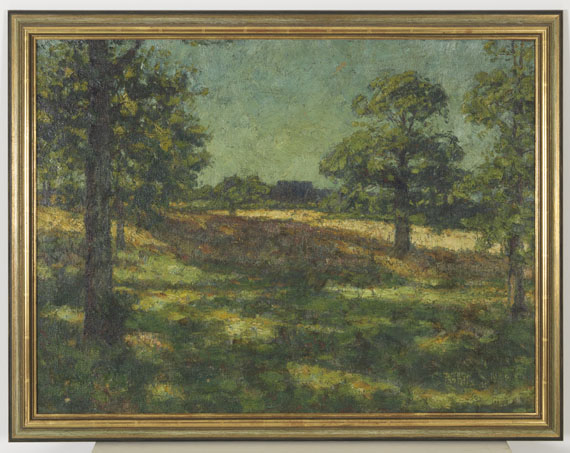300
Christian Rohlfs
Waldlichtung, Um 1900.
Oil on canvas
Estimate:
€ 20,000 / $ 21,400 Sold:
€ 22,500 / $ 24,075 (incl. surcharge)
Waldlichtung. Um 1900.
Oil on canvas.
Not in Vogt. Signed lower right and barely legibly dated. 74,5 x 99 cm (29,3 x 38,9 in).
This work will be presented to the Committee of the Christian-Rohlfs-Archives, Hagen, at the next possible date.
PROVENANCE: Galerie Commeter, Hamburg (with label on stretcher, there with barely legible registration number "1649" (?)).
Springorum, Dortmund (with label on stretcher).
Private collection Southern Germany.
Christian Rohlfs was born in Niendorf in Holstein on 22 December 1849. During a two-year sickbed confinement from 1864-1866 Rohlfs was nursed by a doctor called Stolle, who discovered and supported the painting talent of the boy. At this time, the first drawings came into being. Upon Theodor Storm's suggestion and recommendation, Rohlfs went to Berlin and began his studies of painting at the Großherzogliche Kunstakademie in Weimar in 1870. A leg condition aggravated so badly during the following years that one of his legs was amputated in 1873. His works found approval by the Großherzog von Sachsen-Weimar [Grand Duke of Saxonia-Weimar], who supported him for many years. From 1888 on, an independent stylistic development in parallel to the school of Barbizon and to French Impressionism can be recognised.
Through Henry van de Velde Rohlfs got acquainted with the founder of the Folkwang Museum, Karl Ernst Osthaus in Hagen/ Westphalia. In 1901 Rohlfs moved there to run a painting school according to plans by Osthaus - which failed, however. During a summer stay in Soest in 1905, he got acquainted with Emil Nolde. Rohlfs' own tendency of expressive composition corresponded to the beginning Expressionism of the 'Brücke', to which early exhibitions at the Folkwang-museum attended. After his years of study at the academy, Rohlfs' work was formed for twenty years by Impressionism, but at the age of sixty, he found a late expressionistic style. Favouring tempera on canvas and paper, he also created watercolors and prints. Several honours prove the approval of his later works. In 1929 the Christian Rohlfs Museum in Hagen was founded for the artist's 80th birthday. After the Nazis seized power Rohlfs was expelled from the Preußische Kunstakademie der Künste in 1937 and 412 of his paintings were rated 'degenerate' and were removed from German museums. One year later, on 8 January 1938 Christian Rohlfs died in his studio in Hagen. He was remembered as one of the most important representatives of German Expressionism in art history.
Oil on canvas.
Not in Vogt. Signed lower right and barely legibly dated. 74,5 x 99 cm (29,3 x 38,9 in).
This work will be presented to the Committee of the Christian-Rohlfs-Archives, Hagen, at the next possible date.
PROVENANCE: Galerie Commeter, Hamburg (with label on stretcher, there with barely legible registration number "1649" (?)).
Springorum, Dortmund (with label on stretcher).
Private collection Southern Germany.
Christian Rohlfs was born in Niendorf in Holstein on 22 December 1849. During a two-year sickbed confinement from 1864-1866 Rohlfs was nursed by a doctor called Stolle, who discovered and supported the painting talent of the boy. At this time, the first drawings came into being. Upon Theodor Storm's suggestion and recommendation, Rohlfs went to Berlin and began his studies of painting at the Großherzogliche Kunstakademie in Weimar in 1870. A leg condition aggravated so badly during the following years that one of his legs was amputated in 1873. His works found approval by the Großherzog von Sachsen-Weimar [Grand Duke of Saxonia-Weimar], who supported him for many years. From 1888 on, an independent stylistic development in parallel to the school of Barbizon and to French Impressionism can be recognised.
Through Henry van de Velde Rohlfs got acquainted with the founder of the Folkwang Museum, Karl Ernst Osthaus in Hagen/ Westphalia. In 1901 Rohlfs moved there to run a painting school according to plans by Osthaus - which failed, however. During a summer stay in Soest in 1905, he got acquainted with Emil Nolde. Rohlfs' own tendency of expressive composition corresponded to the beginning Expressionism of the 'Brücke', to which early exhibitions at the Folkwang-museum attended. After his years of study at the academy, Rohlfs' work was formed for twenty years by Impressionism, but at the age of sixty, he found a late expressionistic style. Favouring tempera on canvas and paper, he also created watercolors and prints. Several honours prove the approval of his later works. In 1929 the Christian Rohlfs Museum in Hagen was founded for the artist's 80th birthday. After the Nazis seized power Rohlfs was expelled from the Preußische Kunstakademie der Künste in 1937 and 412 of his paintings were rated 'degenerate' and were removed from German museums. One year later, on 8 January 1938 Christian Rohlfs died in his studio in Hagen. He was remembered as one of the most important representatives of German Expressionism in art history.
300
Christian Rohlfs
Waldlichtung, Um 1900.
Oil on canvas
Estimate:
€ 20,000 / $ 21,400 Sold:
€ 22,500 / $ 24,075 (incl. surcharge)




 Lot 300
Lot 300 

